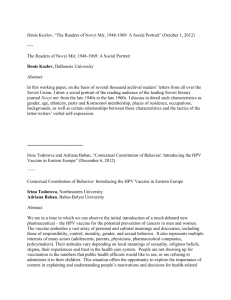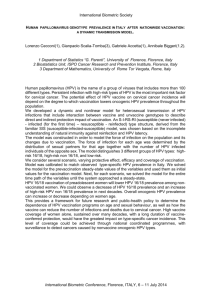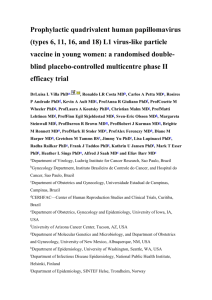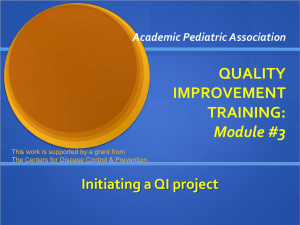Increasing HPV Vaccination Rates
advertisement
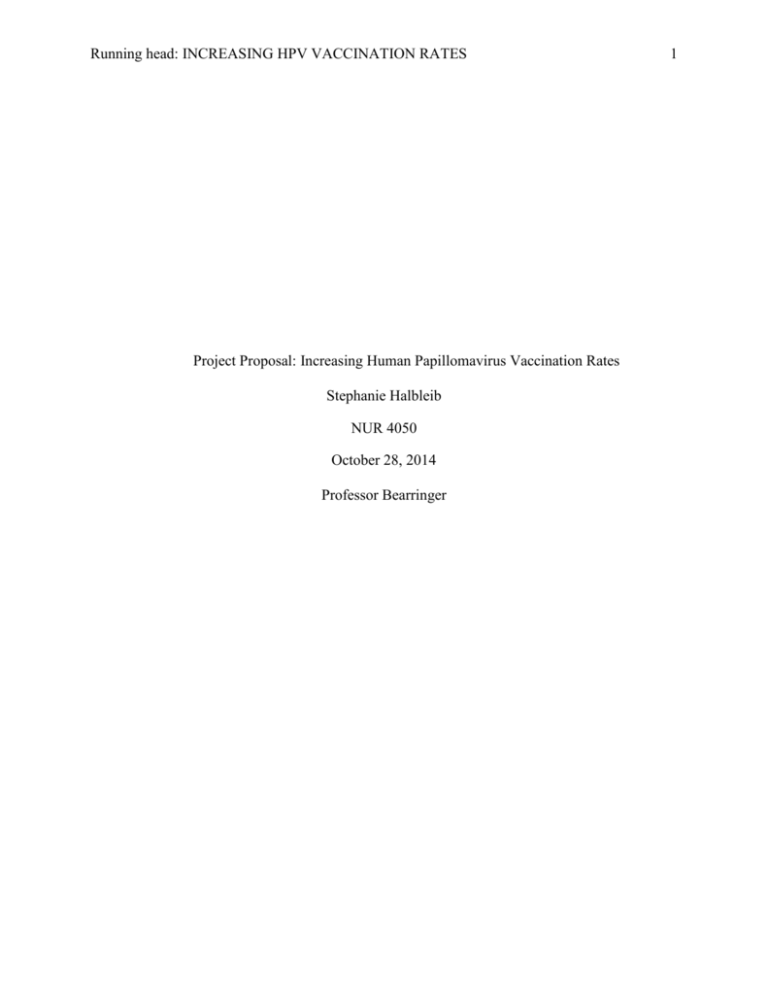
Running head: INCREASING HPV VACCINATION RATES Project Proposal: Increasing Human Papillomavirus Vaccination Rates Stephanie Halbleib NUR 4050 October 28, 2014 Professor Bearringer 1 INCREASING HPV VACCINATION RATES 2 Increasing HPV Vaccine The success of any vaccine or treatment is dependent upon many factors, including the need for support from healthcare professionals and the general public. Further, this support requires an appropriate understanding of the risks associated with human papillomavirus (HPV) as well as the benefits, and drawbacks, of vaccination to prevent an infection. While awareness of HPV is relatively high among healthcare providers, there is an unfortunate is a confusion about the various types of HPV, an uncertainty about how HPV leads to cervical cancer, and little knowledge about the HPV vaccine other than the information presented by the media. Effective HPV education and training programs must be put in place in order to achieve the public health benefit. Leaders within healthcare organizations should continue seeking improvement by using a variety of areas, one critical area to concentrate attention on is teaching nurses to better educate their patient about the HPV vaccine. This in-service can reinforce staff nurses by using the transformational leadership theory, identifying possible barriers to learning, and overcoming barriers with the use of varied teaching methods. Why Vaccinate for Human Papillomavirus Human papillomavirus (HPV) is the most common sexually-transmitted infection in the United States. According to the Centers for Disease Control and Prevention (CDC), most sexually active American men and women will contract at least one type of HPV virus during their lifetime (2012). 74 percent of new infections occur among young people age 15–24. Furthermore, an estimated 33,000 HPV-associated cancers occur annually in the U.S., including an estimated 12,600 HPV-associated cancers in males (Association of Women’s Health, Obstetric and Neonatal Nurses, 2010). INCREASING HPV VACCINATION RATES 3 Although the Gardasil and Cervarix vaccines only cover four out of the more than 100 types of human papillomaviruses they cover the HPV 16 and 18 that are responsible for 70 percent of cervical cancers and HPV 6 and 11 that cause approximately 90 percent of genital warts. These two prophylactic HPV vaccines have been shown in clinical trials to have high efficacy for prevention of infection and associated disease due to HPV types (Association of Women’s Health, Obstetric and Neonatal Nurses, 2010). Nurse leaders have the job of learning about HPV and vaccination options so that they are able to educate teenagers and their parents about HPV, and the HPV vaccination in order to help decrease the prevalence of this sexuallytransmitted infection. Leadership Theory Leaders who desire to make improvements within an organization are faced with a substantially different challenge when teaching patients about the vaccination than they did in years past. A leadership model that would be beneficial in educating nurses about the human papillomavirus vaccination is the transformational leadership theory. Klainberg and Drischel (2010) describe a transformational leader as being “concerned with ensuring that both followers and leaders share the vision to change the organization, and that they will work together toward that common goal” (p. 67). Leaders that use the transformational theory will have better outcomes across the board because everyone is working towards the same goal. The transformational leadership style leads its “followers to levels of higher moral because such leaders do the right thing for the right reason, treat people with care and compassion, encourage followers to be more creative and innovative, and inspire others with their vision” (Marquis & Huston, 2012, p. 14). The instructor can use this theory to empower nurses to strive for improvement through lifelong learning. Empowering the audience with up-to- INCREASING HPV VACCINATION RATES 4 date information will improve nurses’ confidence in educating patients about HPV and vaccination options. Nurses as health educators need to understand their diverse audience and be able respond appropriately to the needs of each member. Transformational leadership theory can be used to empower nurses to accept the responsibility to educate patients correctly about the HPV vaccination. Teaching Method Resistance and barriers of teaching a group of nurses could be overcome by gearing each teaching section to the audience, and utilizing multiple learning tools. A pre-test and post-test is a great tool to assess the amount of knowledge that nurses learned from the presentation. Likewise, giving copies of the presentation would enable the nurses to recall important information. The option for continued education and reinforcement in knowledge allow nurses to provide safe, proficient care to their patients. When nurses understand, when they learn how to better educate their patients about HPV, they will have more positive patient outcomes and increased patient satisfaction also serves to intensify the nurse’s job satisfaction. Using these methods will help to ensure that all nurses are engaged and will retain information for future use. Barriers Successfully teaching a group of nurses requires identification of possible barriers that will likely be encountered. It is important to keep in mind that each nurse will have a different education level about HPV vaccine, come from a different age groups, can have different skill level, come from different cultural backgrounds, or have different factors that impede their willingness to learn. Resistance could be overcome by gearing each in-service to the audience requirements based on the audiences pre-test. Another factor that could hinder nurses from learning is the fact that they do not believe that they should have to re-learn information. INCREASING HPV VACCINATION RATES 5 However, continuing education and reinforcing knowledge allows nurses to provide competent education and safe care to their patients. The nurse needs to understand essential element of normal adolescent development so that the nurse can establish and direct a therapeutic dialogue. Preteens tend to be concrete thinkers, and teenagers are more likely to engage in risky health behaviors. Therefore, nurses need to understand communication with these patient about HPV, the HPV vaccine, and other health issues may be enhanced by listening attentively, using terms the adolescent understands, remaining focused, and avoiding lectures and writing during the course of the conversation. Parents who were not supportive of the HPV vaccine could have convinced their children that the vaccine is harmful or not necessary and the parents have the ultimate say as to whether their child receives the vaccine. Therefore, the uses of transformational leadership would help nurses learn how to better educate teenagers as well as their parents through a collaborative discussion. Conclusion Nurses need to understand the importance of HPV vaccination, so that they can properly educate their patients about the importance of receiving the HPV vaccination. By using the transformational leadership theory, this allows the nurse leader presenting the in-service to direct the teaching towards the goal of ensuring all nurses understand the information about HPV and the HPV vaccination, as well as ensuring they know how to properly inform their patients utilizing the transformational leadership theory. When teaching a group of nurses or informing patients that having varying backgrounds, it is important to identify the barriers of learning and to use a leadership theory that will engage, and aid in successfully teaching the entire audience. INCREASING HPV VACCINATION RATES References Association of Women’s Health, Obstetric and Neonatal Nurses. (2010). HPV Vaccination for the Prevention of Cervical Cancer. Journal of Obstetric, Gynecologic, & Neonatal Nursing, 39(1), 129-130. Retrieved from http://dx.doi.org/10.1111/j.15526909.2009.01097.x. Centers for Disease Control and Prevention. (2012). HPV Vaccine Information for Clinicians. Retrieved from http://www.cdc.gov/std/HPV/STDFact-HPV-vaccine-hcp.htm. Klainberg, M. B., & Dirschel, K. M. (2010). Today's nursing leader: Managing, succeeding, excelling. Sudbury, MA: Jones and Bartlett. Marquis, B., & Huston, C. (2012). Leadership and management tools for the new nurse: A case study approach. Philadelphia, PA: Lippincott Williams & Wilkins. 6

